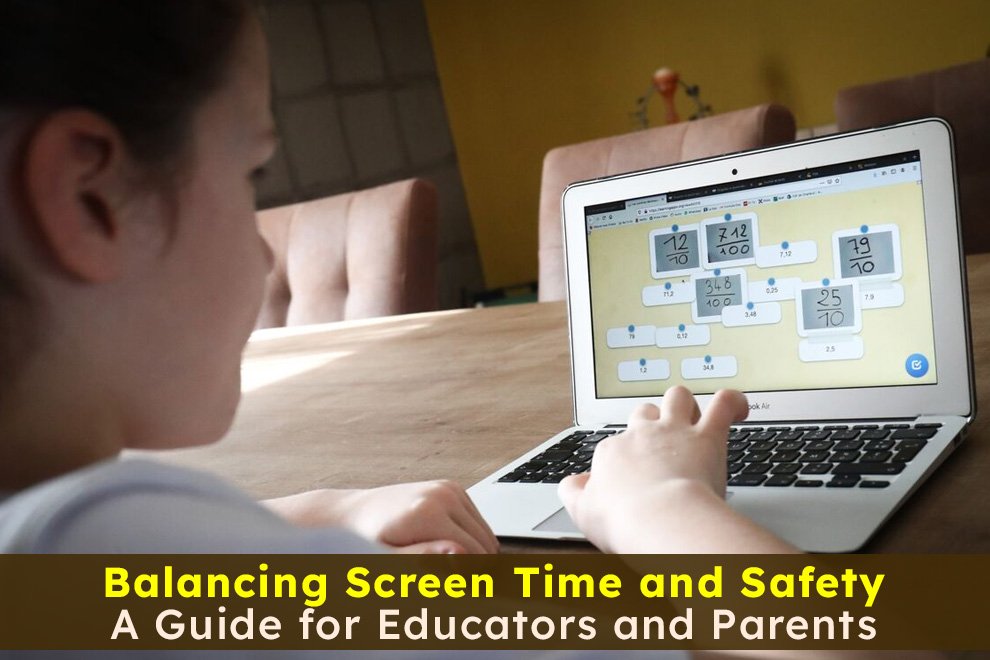In today’s digital age, technology has become an integral part of education, transforming how students learn and engage with information. While devices such as tablets and smartphones offer unprecedented access to educational resources, they also bring challenges, particularly in managing screen time and ensuring children’s safety. Striking the right balance between beneficial screen usage and safeguarding children’s well-being is crucial for educators and parents alike. This guide explores practical strategies for achieving this balance, offering actionable advice to help children navigate the digital world safely.
Understanding the Impact of Screen Time on Children
The influence of screen time on children’s development and health has been a topic of extensive research. Excessive screen use can lead to various issues, including sleep disturbances, decreased physical activity, and impaired social skills. Moreover, prolonged exposure to screens, especially without supervision, can expose children to inappropriate content and online dangers.
It is essential to recognize that not all screen time is created equal. Educational screen time, where children engage with interactive and informative content, can be beneficial. However, even educational use requires careful management to avoid overstimulation and ensure children retain a healthy balance of activities.
Setting Healthy Screen Time Limits
To mitigate the potential negative effects of screen time, setting clear boundaries is vital. Parents and educators should collaborate to establish guidelines that consider the child’s age, developmental stage, and educational needs. For instance, the American Academy of Pediatrics recommends no more than one hour of screen time per day for children aged 2 to 5, focusing on high-quality, age-appropriate content.
For older children, it’s important to encourage breaks and limit recreational screen use, especially before bedtime, to prevent sleep disruptions. Implementing a family media plan that outlines screen-free zones and times, such as during meals and one hour before sleep, can help maintain a balanced routine.
Choosing Safe and Educational Content
Selecting appropriate content is crucial in maximizing the benefits of screen time while ensuring children’s safety. Educators and parents should prioritize apps, games, and videos that are not only educational but also secure. Platforms that offer parental controls and content moderation can provide an added layer of safety, allowing adults to monitor and manage what children access.
Devices specifically designed with safety in mind, such as phones built with kids’ safety in mind, can be particularly valuable. These devices often come with built-in parental controls, safe browsing features, and restrictions on app downloads, making them ideal for younger users who are just starting to explore the digital world.
Encouraging Offline Activities and Physical Exercise
Balancing screen time with offline activities is essential for holistic child development. Physical exercise, creative play, and face-to-face interactions are crucial components of a healthy lifestyle. Encouraging children to participate in outdoor sports, art projects, and social activities helps them develop essential motor skills, creativity, and social competencies that screens cannot provide.
To facilitate this balance, parents and educators can create a schedule that includes designated times for both screen-based and non-screen-based activities. This approach not only limits screen time but also ensures that children receive a well-rounded experience, promoting physical and mental well-being.
Educating Children About Digital Well-being
As children grow older and more independent, it’s important to educate them about digital well-being. This includes teaching them about the potential risks of excessive screen time. Many experts argue that too much screen time disrupts focus, which can affect academic performance and daily functioning.
Educating children about digital citizenship is equally important. This involves understanding online etiquette, recognizing trustworthy sources of information, and knowing how to protect personal information. By equipping children with these skills, parents, and educators can empower them to navigate the digital landscape responsibly and safely.
Creating a Supportive Environment for Healthy Screen Use
A supportive environment plays a significant role in promoting healthy screen use. Open communication between parents, educators, and children is key to understanding and addressing any concerns related to screen time. Regular discussions about the types of content children are consuming, the amount of time they spend online, and their online experiences can help identify potential issues early on.
Additionally, parents and educators should model healthy screen habits. Children are more likely to follow suit if they see adults setting boundaries around their own screen use. This could include prioritizing in-person interactions, setting aside devices during family time, and being mindful of screen time limits.
Logging Off and Striking the Right Balance
Finding the right balance between screen time and safety is an ongoing process that requires collaboration between parents, educators, and children. By setting clear guidelines, choosing safe and educational content, encouraging offline activities, educating about digital well-being, and fostering a supportive environment, we can ensure that children benefit from technology while staying safe.
Incorporating these strategies not only helps in managing screen time but also instills lifelong habits that promote well-being in a digital world. As we continue to embrace technological advancements in education, maintaining this balance will be key to nurturing a generation that is both tech-savvy and health-conscious.
Also Read: Are Your Electronic Gadgets Time Thieves? These 10 Strategies Will Help You to Reduce Screen Time










